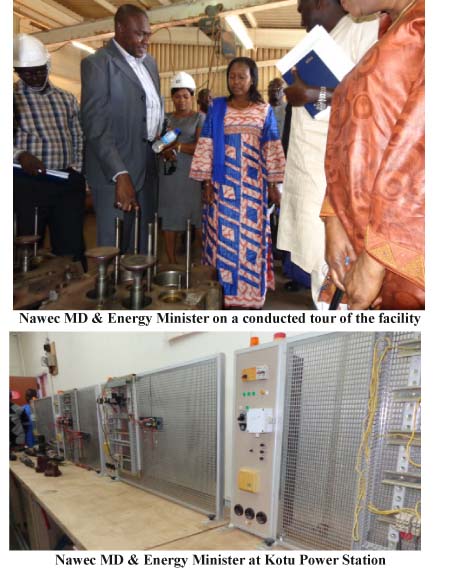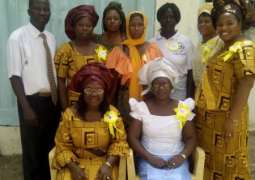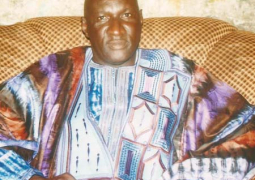
The Honourable Minister of Energy, Mrs Tenengba Jaiteh, has applauded the National Water and Electricity Company, NAWEC, its consultants and contractors for the good work in ensuring quality water and electricity supply to the public.
The Minister was speaking at the end of a two-day familiarization tour of NAWEC’s new projects and installations in the Greater Banjul Area, which commenced on Monday and ended on Tuesday. The tour party included members of NAWEC’s Board of Directors.
The tour covered power stations and water treatment and production facilities, and provided an opportunity to get first-hand information on the progress of the projects that are still being executed, and how they impact on the lives of the people.
The visit covered Kotu Power Station, the Sukuta Water Treatment Plant, the Brufut 100m Elevated Water Tank, Gunjur Water Plant, Brikama Power Plant, and the EDAEF (Energy Development and Access Expansion) Project at the Buffer Zone in Tallinding, all in the Greater Banjul Area.
Accompanied by officials from the Ministry and NAWEC, the Energy Minister pointed out the need for more young Gambians to be equipped to serve in consultancy, contracting as well as in the engineering sector.
The tour was an opportunity for the Minister and NAWEC’s board of directors to know the current status of works at the Kotu Power Station, which included the overhaul of generator G4, G3 and G8 due for maintenance and G1, 6, 7 and 9 running, while G5 expansion is in progress.
The tour was also an opportunity to enable the Minister to see the various services delivered by the workers of the various power plants.
The tour of the Kotu Power Station was conducted by NAWEC Managing Director Ebrima Sanyang, and enabled the Energy Minister and officials to see the various sections of the power station and their operations, such as the control rooms which shelter the various generators, the mechanical and electrical rooms, among others.
The Minister and tour party also visited the Sukuta Water Treatment Plant and was an opportunity to know the capacity of the new project; number of boreholes for the new and existing projects, as well as the ongoing work at the Brufut Water Tank and the newly-completed Gunjur Water Plant which is due to be commissioned soon.
The tour party also visited Brikama Power Station I (former GEG) and heard a briefing on its current status, including the good running condition of G4, G5 and G6; the current ongoing major maintenance of G3 and G2, and the requirement of funds for the maintenance of G1, which shall commence after the completion of ongoing maintenance of G2 and G3, which were also visited.
The Brikama Power Station II (Wartsila plant) was also visited by the tour party, as well as the Brikama Water Treatment Plant (Ballast), among others.
The Transmission and Distribution Expansion work at the Buffer Zone was also visited, where the project manager briefed the Minister and members of her team, on the sub station’s capacity, the impact on the grid, number of villages to benefit from the project and current status of the project.
Speaking during the tour, Mrs Tenengba Jaiteh described water as life,and spoke of its significance to the social and economic development of the nation, stressing that there can be no meaningful development in the absence of quality water and electricity.
She said the Sukuta water plant been one of the critical areas, as water is used in both households and in the industrial area, adding that the Gambia Government wants to ensure quality water and electricity supply to all.
She expressed her appreciation for the good performance of NAWEC’s management and their partners in rendering quality service.
Despite financial constraints, they are working hard to make sure that their goal is achieved, in the interest of the public which depends on water and electric supply.
“The challenge is how to ensure that the water is provided to the households and industries, which requires capital investment for the distribution and networking,” Minister Jaiteh pointed out.
She added that one of their priorities was to ensure that the water being generated from the plants to the boreholes reaches the needy, adding that there was a need to support the Water Division in all possible ways to address the water distribution requirements.
“The most significant thing is to ensure the drilling of the boreholes and that water is generated for the consumers.”
The Energy Minister thanked the President and his government for the tireless support and the enabling environment which has facilitated all kinds of development activities in the country.
She also thanked the NAWEC management and staff for the quality job delivered, for ensuring that the facilities are operated and maintained.
Also speaking during the tour was the NAWEC’s Managing Director, Mr. Ebrima Sanyang, briefed the minister and members of her delegation, during the visit to Kotu Power Station.
According to Mr Sanyang, the installed capacity of the power plant is 39MW, with 15MW currently available (excluding the sets which are currently undergoing short term maintenance, G6 and G4) representing about 40 per cent of the installed capacity.
He said as soon G6 is back, the available capacity would increase to about 21MW, raising the percentage to not only about 54 per cent, but also improving the stability of the entire system.
MD Sanyang said G4 is undergoing its 24,000 hours overhaul. The overhaul is expected to finish by the end of May 2014, which would increase the available capacity to about 27MW, representing about 70 per cent availability.
G3 was shut down since December 2012, for its 12,000 hours overhaul, and is awaiting the availability of funds.
G8 has been down, since January 2011, due to a mechanical problem, Rehabilitation would cost about 1.8 Million Euro.
G7, G9 and G1 are running.
The Kotu Power Generation Expansion Project (G5) is in progress. The invitation for bids was launched, and prospective bidders have started buying the bid document.
The NAWEC MD also highlighted the challenges facing the company at the generation level.
He said there was urgent need for capacity building of the company’s technical staff.
He also stressed the importance of “adequate fuel and oil supply”. “Good stock levels are paramount” not only for reducing maintenance costs, but also for better system stability and longer lifespan of the company’s equipment.
Finally, he emphasized the importance of “selecting right engines for the right purpose”.
He said plans are far advanced in trying to integrate the production to boost the supply. Funds are to be raised to connect from the Kotu police station via the Traffic Lights to link with the Fajara system, which NAWEC is working on tirelessly to achieve towards the end of the year.
“Much needed to be done when it comes to the distribution of water,” he said, adding that there was a need to raise resources to ensure access to quality water.
MD Sanyang said that as soon the T and D project was completed, there would be an improvement on a wider coverage of water supply.
The tour ended at the ongoing energy development and access expansion Project (EDAEP) at the Buffer Zone, a project funded through a loan from the OPEC Fund for International Development (OFID) of US$6,000,000.
The scope of works include design review, materials production, construction, installation and commissioning of a 33kv line from the Brikama power station routed through the road passing via Bafuloto, Makumbaya to Mandinari, Lamin village and terminating in a 10MVA, 33/11KV substation at Buffer Zone, Tallinding, from which it would emanate three 11Kv feeders to link with the existing NAWEC 11Kv network.
The impact of the project was set to significantly reduce the bottleneck in the transmission and distribution system, while increasing flexibility of operations, improving reliability, as well as, introducing some redundancy in the system.
It would also cover for extra power evacuation capacity from the power stations in Brikama and for the provision of access to energy services (electricity) for the involved villages; thus improving the people’s quality of life.
Part of the project works is said to include provision of electricity through construction of Low Voltage Networks (33/0.4kV) for ten villages namely: Bafuloto, Makumbaya, Kubariko, Galloya, Kubuneh, Jaataya, Mandinari, Kerewan, Darusalam and Daranka.



